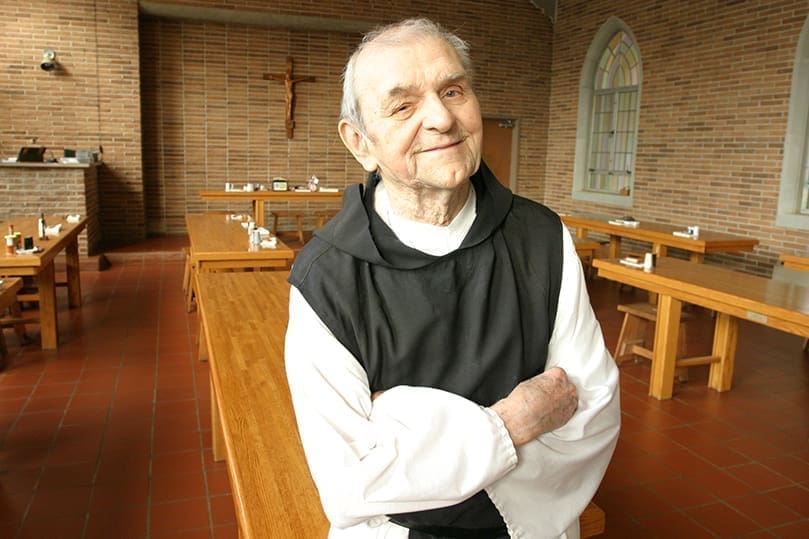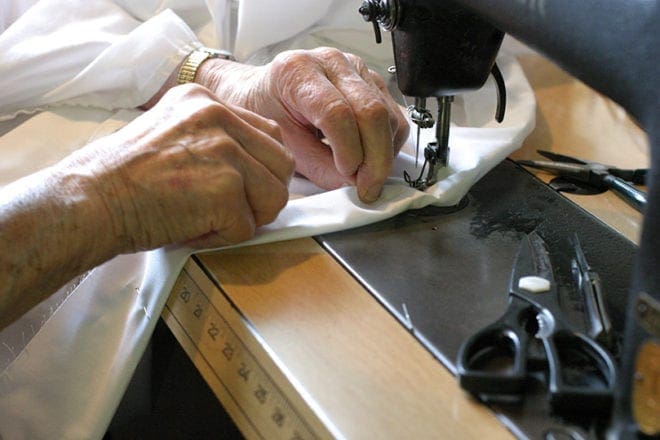 Photo By Michael Alexander
Photo By Michael AlexanderConyers
A Founder Observes The Monastery’s 65th Birthday
By ANDREW NELSON, Staff Writer | Published March 19, 2009
At 97, he is an energetic and talkative fellow, who is able to trace the story of the institution some 30 miles east of Atlanta, from its start in a 100-year-old barn to the “pineboard monastery” to the monastic complex on 2,000 acres. He is the last living founder.
The monastery marks 65 years since its founding on March 21—the feast day of St. Benedict, the purported day of his death. That day in 1944, 20 pilgrim monks from Kentucky started a new house of Cistercian religious life in Rockdale County.
A two-day deluge of spring rain greeted them as they settled in the barn at what had been Honey Creek plantation. The tin-roofed barn was their home for eight months during the construction of the pineboard monastery.
At the first supper, to fortify the men for the work ahead, they prepared “soup, potatoes, hard-boiled eggs, butter, bread and our famous barely coffee drink,” according to an account typed by Father Luke. “That was considered a very sumptuous meal for monks on those days!”
Monks were an unfamiliar sight in the Deep South. Atlanta was part of the Diocese of Savannah.
“We were not really welcomed in the South. There was not even a Catholic family in Conyers,” said Father Luke as he ate his breakfast of toasted rye bread and decaf coffee in the infirmary March 9.
More than 40 monks live here following in the centuries-old rule of St. Benedict. The monks are working to ensure their sustainability in the years ahead. Their plan is to strengthen retreat work and link the institution to a national heritage area that crosses their property.

The hands of Father Luke Kot stitch the hem of a habit at one of the 80-year-old Singer sewing machines in the monastery’s tailor shop. Photo By Michael Alexander
Abbot Francis Michael called Father Luke a “genial lover of the community.”
He is “especially gracious with the new and younger members, regaling them with stories of the old days,” said the abbot in an e-mail.
During most of the building years, Father Luke was the secretary to the abbot of that era and sent thousands of thank you notes to benefactors.
“All those names were reverently and gratefully placed within our main altar in the Abbey Church where they are continually remembered before God,” Abbot Francis Michael said.
“We are happy to be celebrating the blessings of 65 years here in Conyers and look forward with God’s grace to be here for many, many years to come,” said the abbot.
Father Luke has wispy white hair, blue eyes and wears a black skullcap. A three-wheeled walker—with a miniature Georgia vanity license plate of “Luke”—helps with his balance. He joked how a nurse told him he was always “rushing, rushing around,” but he’d insisted he was Polish, not Russian.
He prays with the community throughout the day. But due to his age the abbot has forbidden him to attend the 4 a.m. vigil prayer that starts a monk’s day. And at the 7:30 p.m. compline, Father Luke often says the prayers in his room.
He is the son of illiterate Polish immigrants, whose father worked as a carpenter and mother as a midwife. He knew early he wanted a life in a monastery. A magazine he got at home in Niagara Falls, N.Y., introduced him to the Cistercians, formally known as the Order of Cistercians of the Strict Observance. The community is also known as Trappists referring to the La Trappe Abbey in France, where it began as a reform movement in the 17th century.
“I decided that was the life I would lead,” he said.
On Oct. 28, 1938, at the age of 27, he became a novice at Our Lady of Gethsemani monastery in Kentucky. Father Luke’s time there overlapped with that of the famous writer and monk, Thomas Merton.
“He was not given any special (attention). He was a simple novice,” said Father Luke.
Monks kept silence throughout the day when Father Luke began, except in special rooms. They communicated with sign language.
“I lived it for 30 solid years. We didn’t talk at all, not speaking everywhere,” he said.
Without skipping a beat, Father Luke rubbed his belly for good and touched his cheek to show “good day” and rubbed his nose and touched his cheek for “bad day.”
A monastery should be peaceful, so people are not distracted, he said.
“When you are praying or walking, you want silence. It is not a law. It is a gift of God. If you don’t know silence, then you have difficulty in praying. You learn. After you learn to be silent then you live a better life of peace and quiet,” he said.

Ninety-seven-year-old Cistercian monk Father Luke Kot participates in lauds (morning prayer) at the Monastery of the Holy Spirit, Conyers, March 9.Photo By Michael Alexander
The outside world never had much of an appeal for him. But once as a young monk, he was determined to leave and told his mother to expect him. But he remained after a change of heart. He lived his life within the walls of the monastery, and it taught him a gentle side of God.
“God isn’t picky-choosy like we are,” he said. “God takes everything you give him because God is love.”
He encouraged his visitors to “pray for everything and use your own words.”
Living in the company of monks cultivated in Father Luke an openness to serving the community’s needs before his own.
A factory laborer after graduating from high school, Father Luke set out to live as a brother and perform manual labor. However, a superior told him to get an education to become a priest.
It was the first of many times he was asked to imagine different goals for himself. He served as the abbot’s secretary for years, despite asking instead to fill wheelbarrows during the monastery construction.
Then he became responsible for the monks’ distinctive habits.
“I didn’t know what a stitch looked like,” he joked.
But he took up the assignment on faith. For more than 50 years, Father Luke was the only tailor for the scores of men. He stitched the white habits, the black scapulars and anything else that needed to be mended.
In the large third-floor room where he sews, every table surface and cubbyhole is filled with odds and ends. Father Luke calls the place a “junkyard” and promises it’ll get clean.
He knows the ebb and flow that accompanies his work, such as the rush of requests for new habits or for old ones to be tidied up when men make their vows.
Knowing that he was the only monk trained in what he calls the “sew-sew” trade, Father Luke planned ahead. He rushed in June to finish scores of habits and scapulars before he gave up working at the 80-year-old Singer sewing machine.
Now, he teaches an apprentice, Brother Giovanni dell Croce, the craft of sewing stitches, making pockets and hemming garments.
“I’m content. The point is I am just a person who is a monk,” he said. “I am just like you people. We have to learn gradually what life is all about. It takes time.”